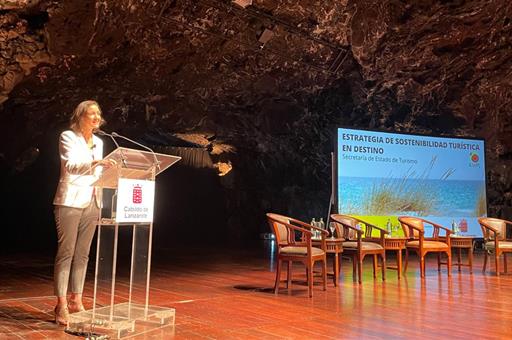Informative workshop in Lanzarote
Ministry of Tourism presents its Sustainability Strategy for destinations with public investment of 1.91 billion euros
News - 2021.4.19
The Minister for Industry, Trade and Tourism, Reyes Maroto, presented, together with the President of the Regional Government of the Canary Islands, Ángel Víctor Torres, the general lines of the Tourism at Destination Strategy, which will lay the foundations for a new tourism model to transform destinations in accordance with sustainable criteria aligned with the Sustainable Development Goals (SDG) of the 2030 Agenda, within the framework of the 'Spain can' Recovery, Transformation and Resilience Plan.
The presentation also involved the participation of the President of the Island Council of Lanzarote, María Dolores Corujo, the Chairman of the Tourism Committee of FEMP, Alfonso Rodríguez Badal, the State Secretary for Tourism, Fernando Valdés, and the Councillor for Tourism of the Regional Government of the Canary Islands, Yaiza Castilla.
During the event, held in Lanzarote, the Minister for Tourism stated that "the future of tourism will either be sustainable or not. Accordingly, over the next three years, we will invest more than 1.9 billion euros in our tourism destinations to strengthen their sustainability in its three dimensions: environmental, socio-economic and territorial".
"From our most international sun and sea destinations to inland villages, including large cities and urban destinations with a tourism identity, we will support our destinations to transform them into genuine hubs of innovation and resistant tourism attractions to tackle such challenges as climate change and digitalisation, and contribute to diversify our offer and seasonally adjust the demand to attract higher-spending tourists", added the minister.
Drawn up by the State Secretariat for Tourism with the participation of the tourism councillor of the autonomous regions and the Spanish Federation of Municipalities and Provinces (Spanish acronym: FEMP), the strategy establishes the goals and expected results of the programmes of Sustainability Plans, while defining the categories of destination in which these actions will be implemented.
"We are looking for balanced development of our tourism potential, sharing the wealth that this activity generates throughout the country, also creating job opportunities in those areas affected by depopulation. Another of the goals the strategy seeks is to increase the competitiveness of destinations, incorporating sustainability and digitalisation in the management of tourism resources, infrastructures and products, and improving the quality and the natural capital of the tourism system", explained the State secretary, Fernando Valdés, in his speech.
Types of destination
Sun and sea tourism destination
This accounts for 65% of the whole offer in our country and faces a profound change of competitive paradigm. The strategy seeks to increase its competitiveness, strengthening the variety of tourist experiences and the management of these experiences thanks to digital tools and the constant raising of quality standards.
Rural tourism destination
With great tourism potential and a broad scope for development, the aim of this Strategy is the integration of rural tourism in the tourism system, complying with the aims of the demographic challenge and contributing to seasonal adjustments, reducing the concentration of tourism and re-distributing income from tourism. It also seeks to improve the quality of life of its populations, creating job opportunities, making older social communities more dynamic, generating an associative fabric and enhancing local businesses.
Urban tourism destination
This accounts for approximately a quarter of the international tourism demand in Spain. The Strategy will promote the renewal of the cultural offer and leisure, extending and diversifying areas of interest and the introduction of digital tools that allow tourist flows to be better managed. It will also improve old towns, reconciling the uses of neighbourhoods and commit to challenges associated with green mobility and naturalising cities.
General aims
The Tourism at Destination Strategy responds to two general aims. Firstly, to support Spanish tourist destinations, whatever their scale and type of demand they respond to, in a transformation process that leads them to become hubs of tourism innovation, able to integrate environmental, socio-economic and territorial sustainability in their offer and to develop resilience strategies to the new challenges of the tourism ecosystem, from climate change to the over-demand of tourism and health and safety crises.
The second aim is to achieve greater territorial cohesion, not just relating the offer and destinations in each region, but creating connections between the destinations in different regions. In this regard, the Sustainability Strategy seeks balanced development of the tourism potential through the country while seeking to bed down ties of solidarity in communities such that they contribute to solving common problems.
Expected results
The results expected from the Strategy are, firstly, to improve tourist destinations thanks to investments in key actions to enhance their competitiveness that have a knock-on effect on tourism demand and help make the private tourist sector more dynamic; secondly, to effectively incorporate sustainability and digitalisation in managing tourism resources, infrastructures and products in destinations; thirdly, to diversify the offer of tourist destinations to contribute to the creation of job opportunities and economic activity, redistribute income and foster territorial cohesion while reducing the concentration of demand; and fourthly and lastly, improve the natural capital of the tourism system, guaranteeing its continuity over time by reducing emissions, improving the management of waste and water, the protection, restoration and tourism harnessing of ecosystems, bringing nature back to destinations and introducing prevention and mitigation actions from the effects of climate change.
Non official translation





